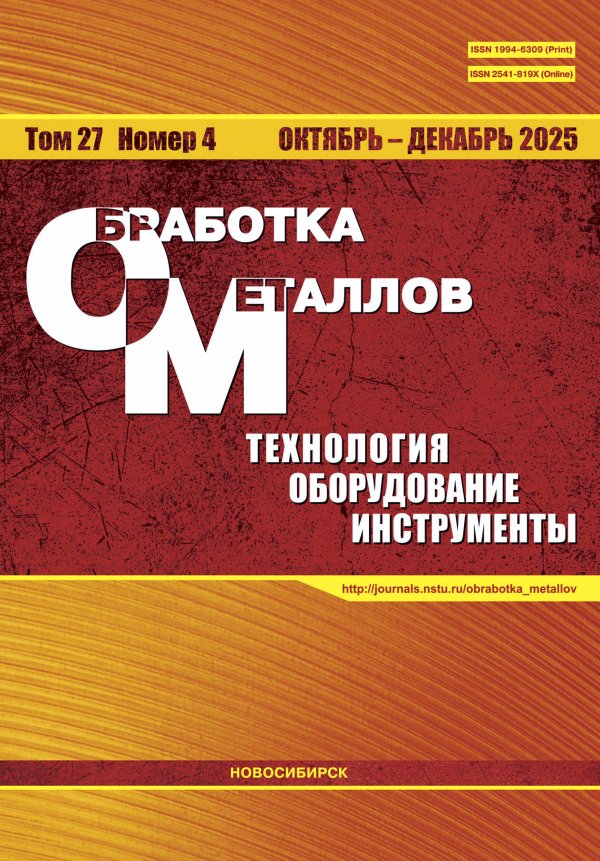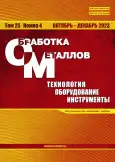Моделирование эрозионного износа титанового сплава высокоскоростным потоком частиц
- Авторы: Строкач Е.А.1, Кожевников Г.Д.1, Пожидаев А.А.1, Добровольский С.В.1
-
Учреждения:
- Выпуск: Том 25, № 4 (2023)
- Страницы: 268-283
- Раздел: МАТЕРИАЛОВЕДЕНИЕ
- URL: https://journal-vniispk.ru/1994-6309/article/view/301475
- DOI: https://doi.org/10.17212/1994-6309-2023-25.4-268-283
- ID: 301475
Цитировать
Аннотация
Об авторах
Е. А. Строкач
Email: evgenij.strokatsch@mai.ru
канд. техн. наук, Московский авиационный институт (национальный исследовательский университет), Волоколамское шоссе, 4, г. Москва, 125993, Россия, evgenij.strokatsch@mai.ru
Г. Д. Кожевников
Email: kozhevnikov.mai@yandex.ru
Московский авиационный институт (национальный исследовательский университет), Волоколамское шоссе, 4, г. Москва, 125993, Россия, kozhevnikov.mai@yandex.ru
А. А. Пожидаев
Email: pozhidaev.mai@xmail.ru
Московский авиационный институт (национальный исследовательский университет), Волоколамское шоссе, 4, г. Москва, 125993, Россия, pozhidaev.mai@xmail.ru
С. В. Добровольский
Email: dobrovolskiy_s@mail.ru
канд. техн. наук, доцент, Московский авиационный институт (национальный исследовательский университет), Волоколамское шоссе, 4, г. Москва, 125993, Россия, dobrovolskiy_s@mail.ru
Список литературы
- Analysis of micro and nano particle erosion by analytical, numerical and experimental methods: A review / S.M. Shinde, D.M. Kawadekar, P.A. Patil, V.K. Bhojwani // Journal of Mechanical Science and Technology. – 2019. – Vol. 33 (5). – P. 2319–2329. – DOI: 10.1007.s12206-019-0431-x.
- Computational fluid dynamics (CFD) based erosion prediction model in elbows / H.D. Hadziahmetovic, N. Hodzic, D. Kahrimanovic, E. Dzaferovic // Tehnicki vjesnik = Technical Gazette. – 2014. – Vol. 21 (2). – P. 275–282.
- Sun K., Lu L., Jin H. Modeling and numerical analysis of the solid particle erosion in curved ducts // Abstract and Applied Analysis. – 2013. – Vol. 2013. – Art. 245074. – doi: 10.1155/2013/245074.
- Finnie I. Erosion of surfaces by solid particles // Wear. – 1960. – Vol. 3 (2). – P. 87–103. – doi: 10.1016/0043-1648(60)90055-7.
- Grant G., Ball R., Tabakoff W. An experimental study of the erosion rebound characteristics of high-speed particles impacting a stationary specimen: Report No. 73-36. – Cincinnati University Ohio, Department of Aerospace Engineering, 1973.
- Bitter J.G.A. A study of erosion phenomena: Part I // Wear. – 1963. – Vol. 6 (1). – P. 5–21. – doi: 10.1016/0043-1648(63)90003-6.
- Bitter J.G.A. A study of erosion phenomena: Part II // Wear. – 1963. – Vol. 6 (3). – P. 169–190. – doi: 10.1016/0043-1648(63)90073-5.
- Строкач Е.А., Кожевников Г.Д., Пожидаев А.А. Численное моделирование процесса эродирования твердыми частицами в газовом потоке (обзор) // Вестник ПНИПУ. Аэрокосмическая техника. – 2021. – № 67. – С. 56–69. – doi: 10.15593/2224-9982/2021.67.06.
- Tarodiya R., Levy A. Surface erosion due to particle-surface interactions – A review // Powder Technology. – 2021. – Vol. 387. – P. 527–559. – doi: 10.1016/j.powtec.2021.04.055.
- Krella A. Resistance of PVD coatings to erosive and wear processes: A review // Coatings. – 2020. – Vol. 10. – P. 921. – doi: 10.3390/coatings10100921.
- Fardan A., Berndt C.C., Ahmed R. Numerical modelling of particle impact and residual stresses in cold sprayed coatings: A review // Surface and Coatings Technology. – 2021. – Vol. 409. – doi: 10.1016/j.surfcoat.2021.126835.
- Bonu V., Barshilia H.C. High-temperature solid particle erosion of aerospace components: its mitigation using advanced nanostructured coating technologies // Coatings. – 2022. – Vol. 12. – P. 1979. – doi: 10.3390/coatings12121979.
- Taherkhani B., Anaraki A.P., Kadkhodapour J. Erosion due to solid particle impact on the turbine blade: experiment and simulation / B. Taherkhani, A.P. Anaraki, J. Kadkhodapour, N.K. Farahani, H. Tu // Journal of Failure Analysis and Prevention. – 2019. – Vol. 19 (6). – P. 1739–1744. – doi: 10.1007/s11668-019-00775-y.
- Khoddami A.S., Salimi-Majd D., Mohammadi B. Finite element and experimental investigation of multiple solid particle erosion on Ti–6Al–4V titanium alloy coated by multilayer wear-resistant coating // Surface and Coatings Technology. – 2019. – Vol. 372 (2). – P. 173–189. – doi: 10.1016/j.surfcoat.2019.05.042.
- Numerical modeling of sand particle erosion at return bends in gas-particle two-phase flow / A. Farokhipour, Z. Mansoori, M. Saffar-Avval, G. Ahmadi // Scientia Iranica. – 2018. – Vol. 25 (6). – P. 3231–3242. – doi: 10.24200/sci.2018.50801.1871.
- Numerical analysis of particle erosion in the rectifying plate system during shale gas extraction / S. Peng, Q. Chen, C. Shan, D. Wang // Energy Science & Engineering. – 2019. – Vol. 7 (5). – P. 1838–1851. – doi: 10.1002/ese3.395.
- Prediction of particle erosion in the internal cooling channels of a turbine blade / D. Anielli, D. Borello, F. Rispoli, A. Salvagni, P. Venturini // 11th European Turbomachinery Conference, 23 March 2015, Madrid, Spain. – Madrid, 2015. – P. 1–11.
- Numerical study of erosion due to solid particles in steam turbine blades / A. Campos-Amezcua, Z. Mazur, A. Gallegos-Muñoz, A. Romero-Colmenero, J. Manuel Riesco-Ávila, J. Martín Medina-Flores // Numerical Heat Transfer, Part A: Applications. – 2008. – Vol. 53 (6). – P. 667–684. – doi: 10.1080/10407780701453933.
- Arabnejad H. Development of erosion equations for solid particle and liquid droplet impact. Ph.D. diss. / Department of Mechanical Engineering, The University of Tulsa. – Tulsa, 2015. – 161 p.
- Mansouri A. A combined CFD-experimental method for developing an erosion equation for both gas-sand and liquid-sand flows. Ph.D. diss. / Department of Mechanical Engineering, The University of Tulsa. – Tulsa, 2016. – 217 p.
- Effect of morphology, impact velocity and angle of the CaO-MgO-Al2O3-SiO2 (CMAS) particle on the erosion behavior of thermal barrier coatings (TBCs): a finite element simulation study / Y. Liu, Z. Cao, J. Yuan, X. Sun, H. Su, L. Wang // Coatings. – 2022. – Vol. 12 (5). – P. 576. – doi: 10.3390/coatings12050576.
- Finite element simulations on erosion and crack propagation in thermal barrier coatings / Z.S. Ma, L.H. Fu, L. Yang, Y.C. Zhou, C. Lu // High Temperature Materials and Processes. – 2015. – Vol. 34 (4). – P. 387–393. – doi: 10.1515/htmp-2014-0068.
- Finite element analysis of erosive wear for offshore structure / Z.G. Liu, S. Wan, V.B. Nguyen, Y.W. Zhang // 13th International Conference on Fracture, 16–21 June 2013, Beijing, China. – Beijing, China, 2013. – P. 461–468.
- Oviedo F., Valarezo A. Residual stress in high-velocity impact coatings: parametric finite element analysis approach // Journal of Thermal Spray Technology. – 2020. – Vol. 29 (6). – P. 1268–1288. – doi: 10.1007/s11666-020-01026-5.
- Bing Wu, Fengfang Wu, Jinjie Li. Finite element modeling of correlating mechanical properties with erosion wear rate // Proceedings of the 2018 3rd International Conference on Electrical, Automation and Mechanical Engineering (EAME 2018), June 2018. – Atlantis press, 2018. – P. 273–276. – doi: 10.2991/eame-18.2018.57.
- Singh P.K., Hota A.R., Mishra S.B. Finite element modelling of erosion parameters in Bing boiler components // Asian Journal of Engineering and Applied Technology. – 2018. – Vol. 7 (2). – P. 12–16. – doi: 10.51983/ajeat-2018.7.2.964.
- Modeling, simulation, and analysis of the impact(s) of single angular-type particles on ductile surfaces using smoothed particle hydrodynamics / X. Dong, Z. Li, L. Feng, Z. Sun, C. Fan // Powder Technology. – 2017. – Vol. 318. – P. 363–382. – doi: 10.1016/j.powtec.2017.06.011.
- FVPM numerical simulation of the effect of particle shape and elasticity on impact erosion / S. Leguizamón, E. Jahanbakhsh, S. Alimirzazadeh, A. Maertens, F. Avellan // Wear. – 2019. – Vol. 430–431. – P. 108–119. – doi: 10.1016/j.wear.2019.04.023.
- Menter F., Lechner R., Matyushenko A. Best practice: generalized K-Ω two-equation turbulence model in ANSYS CFD (GEKO): Technical Report ANSYS. – Nurnberg, Germany, 2019. – 32 p.
- ANSYS Fluent Theory Guide. – Canonsburg, PA: ANSYS Inc, 2019. – 1080 p.
- Menter F., Matyushenko A., Lechner R. Development of a generalized K-ω two-equation turbulence model // Notes on Numerical Fluid Mechanics and Multidisciplinary Design. – 2018. – Vol. 142. – P. 101–109. – doi: 10.1007/978-3-030-25253-3_10.
- Simulation of a GOx-gch4 rocket combustor and the effect of the GEKO turbulence model coefficients / E. Strokach, V. Zhukov, I. Borovik, A. Sternin, O.J. Haidn // Aerospace. – 2021. – Vol. 8 (11). – P. 341. – doi: 10.3390/aerospace8110341.
- Pozhidaev A., Kozhevnikov G., Strokach E. Numerical study of turbulence model effect on solid particle erosion in gaseous flow // AIP Conference Proceedings. – 2023. – Vol. 2549 (1). – P. 030003. – doi: 10.1063/5.0130489.
- The impact angle dependence of erosion damage caused by solid particle impact / Y.I. Oka, H. Ohnogi, T. Hosokawa, M. Matsumura // Wear. – 1997. – Vol. 203–204. – P. 573–579. – doi: 10.1016/s0043-1648(96)07430-3.
- Sand erosion of wear resistant materials: Erosion in choke valves / K. Haugen, O. Kvernvold, A. Ronold, R. Sandberg // Wear. – 1995. – Vol. 186–187. – P. 179–188. – doi: 10.1016/0043-1648(95)07158-X.
- The role of inter-particle collisions on elbow erosion / C.A. Duarte Ribeiro, F. Souza, R. Salvo, V. Santos // International Journal of Multiphase Flow. – 2016. – Vol. 89. – P. 1–22. – doi: 10.1016/j.ijmultiphaseflow.2016.10.001.
- Recommended practice RP O501 Erosive wear in piping systems. Revision 4.2-2007 (DNV RP O501 – Revision 4.2-2007). – Det Norske Veritas, 2007. – 43 p.
- Haider A., Levenspiel O. Drag coefficient and terminal velocity of spherical and nonspherical particles // Powder Technology. – 1989. – Vol. 58 (1). – P. 63–70. – doi: 10.1016/0032-5910(89)80008-7.
- Morsi S.A., Alexander A.J. An investigation of particle trajectories in two-phase flow systems // Journal of Fluid Mechanics. – 1972. – Vol. 55, pt. 2. – P. 193–208. – doi: 10.1017/s0022112072001806.
- ImageJ. Image Processing and Analysis in Java. – URL: https://imagej.net/ij/index.html (accessed: 31.10.2023).
Дополнительные файлы







